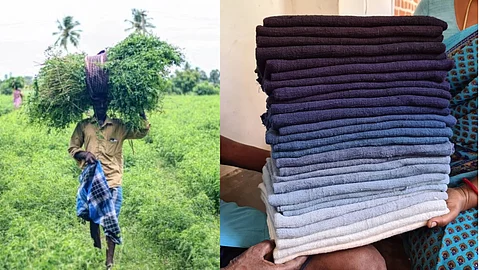
- HOMEGROWN WORLD
- #HGCREATORS
- #HGEXPLORE
- #HGVOICES
- #HGSHOP
- CAREERS
- ABOUT US
- CONTACT US

Indigo, also termed the King Of Dyes, has a rich and storied history that cements its place in the Indian culture and trade dating to four thousand years ago. Indigo textiles have been discovered in Egyptian tombs from the late Bronze Age, indicating that the trade of indigo from India to distant lands had already gained momentum. Unlike other dyes that could easily wash out, Indian indigo had a unique quality that bonded to fabric like no other and lasted as long as the fabric did, which made it a commercially viable trade for the colonial administration to exploit. The sixteenth century saw Portuguese, Dutch and British mercantile entering the Indigo trade, which eventually became a monopoly for the British Raj.
As Indigo production was ramped up, the Indian farmers were forced to abandon food and crop plantations to tend to the money-making Indigo dyes. This had disastrous consequences like the Great Bengal Famine, and subsequently, a revolt by the farmers against the inhumane oppression being doled out by the British. Indigo dyes assumed a life of their own during this time period, but towards the end of the nineteenth century, they were dethroned by the novel synthetic dyes which were a cheaper and more convenient alternative than indigo, rendering their commercial benefits void.
Years later, a minuscule research unit called ‘The Colours of Nature’ was established in Auroville, Tamil Nadu, and it set out to resuscitate the dying art of Indigo dyes. Founded by Jesus Ciriza Larraona in 1993, it drew on Auroville’s rich and textured knowledge about the process of indigo production to help revive the sustainable and eco-friendly practice.
Unlike synthetic indigo dyes which rely on toxic chemicals like formaldehyde to make the dye, The Colours of Nature follows a traditional approach that produces skin-friendly, non-carcinogenic, and biodegradable dyes. Moreover, their vats to make the dye have used the same water since 1993, limiting water waste, as well as the risk of toxic buildups that could pollute the environment.
India’s new wave of sustainability and slow-fashion is cultivating an environment for units like TCoN to expand cultivation, which in turn should lead to more fertile soil and provide livelihoods to rural women gatherers as well as local artisans.
You can find out more about The Colours Of Nature here.
